ASUS ZenWatch review: subtle and stylish, with a few shortcomings
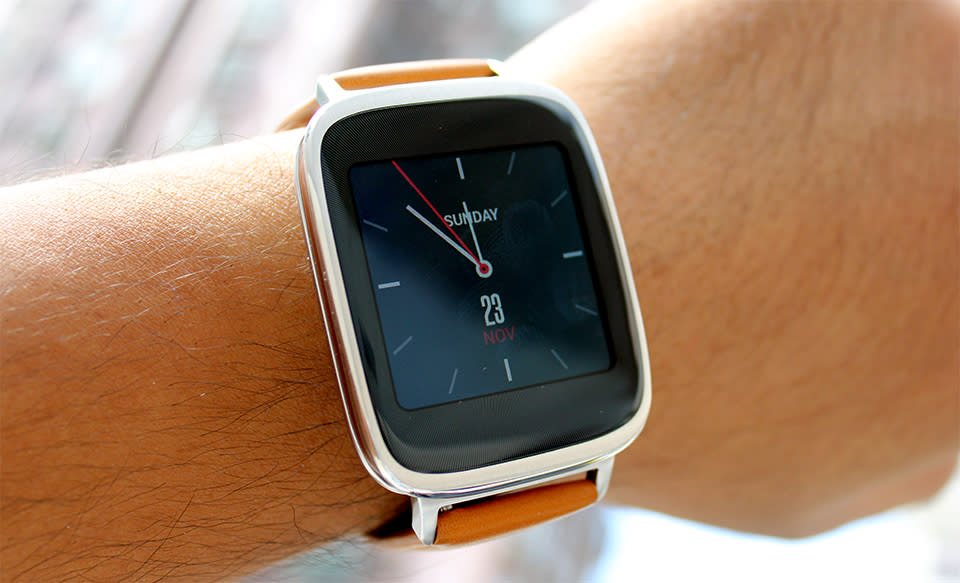
The war for your wrist isn't going to wind down any time soon: We've already seen the industry's biggest players take a stab (in some cases, multiple ones) at perfecting their wearables. ASUS isn't quite as prominent as other names on that list, but that just makes its $200 ZenWatch all the more interesting The Taiwanese company -- probably best known for its quirky phone-tablet hybrids -- has put together an inaugural smartwatch that's dripping with style. In fact, it's the first smartwatch I've worn that's ever attracted random compliments from passersby (in two countries, no less), not to mention the first one that didn't make me feel like a complete nerd while wearing it. Alas, it takes more than just a sweet face to make a smartwatch worth owning.
Hardware
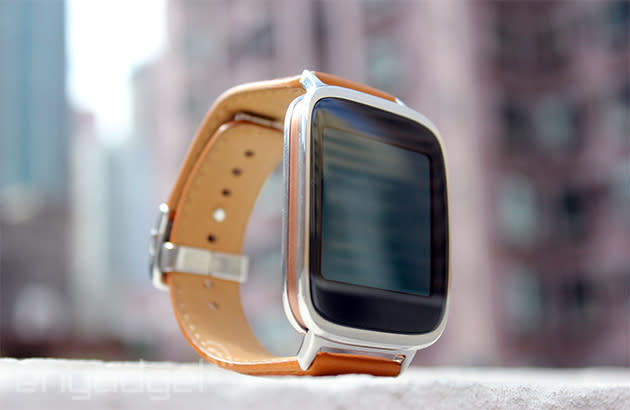
A sense of style and personality is crucial for wearables; it's the difference between tossing something in the drawer after it's technically obsolete and wearing it anyway just because you like it. The ZenWatch falls squarely into that latter category, at least as far as I'm concerned. ASUS has put together a handsome, understated piece of kit that many people will feel proud wearing. So what's so nice about it? Well, for starters, the simple, curvy chassis is hewn from two layers of stainless steel sandwiching a rosy gold, steel midsection that helps to break up what otherwise would've been a monotonous, 75-gram silver slab. It might not be everyone's cup of tea, but I think the rounded "2.5D" body and two-tone trim were smart decisions -- they make the watch feel understated and classy in a market that all too easily forgets what those words mean. In that respect, the ZenWatch lands somewhere in between the first, utilitarian batch of Android Wear watches and newer, flashier models like the Moto 360 and LG G Watch R. Definitely not a bad niche to camp out in.
You might not agree with ASUS' design choices, but you can't blame the company for shooting for style when it has the same dual-core 1.2GHz Snapdragon 400 and 512 of RAM that've popped up in nearly every other Android Wear watch to date. There's also 4GB of flash storage under the hood in case you want to listen to music on the run without having to lug around a phone while you're at it, though that's hardly novel either.

My review unit came with a caramel-colored, stitched leather wristband that's both fetching and comfortable, a proposition that's tougher to nail than you might think. I'm no watch maven, but I've come across plenty of pretty leather straps that are too stiff and creaky until they're properly broken in. Not so here. The ZenWatch's band felt supple on my wrist from the get-go. And hey, you can swap out that stock leather band with any other 22mm strap you've got lying around. That's probably for the best too, especially if you're the sort to wear snug shirts: At its biggest, the metallic clasp that lashes one end of the band to the other is even thicker than the watch itself, making it sometimes troublesome to pull a sleeve over. On the plus side, the ZenWatch's body is water-resistant, so it'll survive bathroom splashes and other accidents (just try to keep the water away from all that leather).
Right, that's enough fawning -- let's get to the disappointing stuff. Sitting right up top is the square, 1.63-inch AMOLED screen swathed in a de rigueur panel of Corning's Gorilla Glass 3 to keep it from getting banged up. Unfortunately, there's quite a bit of bezel separating the ring of steel trim from the screen itself, and it's probably the most disappointing thing about the ZenWatch's looks. All that unused space makes the screen seem smaller than it actually is, and it doesn't help that the bezel has a slightly textured look as if it's just begging to be noticed. Some better button placement would've helped a lot, too. We'll dig into the software in a bit, but here's a quick spoiler: The folks at ASUS seem to be huge fans of the analog clock aesthetic, so a crown wouldn't look too out of place on the ZenWatch. Frankly, it'd make a much better power button than the one we actually got; it's a tiny little thing that sits flush with the rest of the body, so it's tough to find by feel alone.
Display
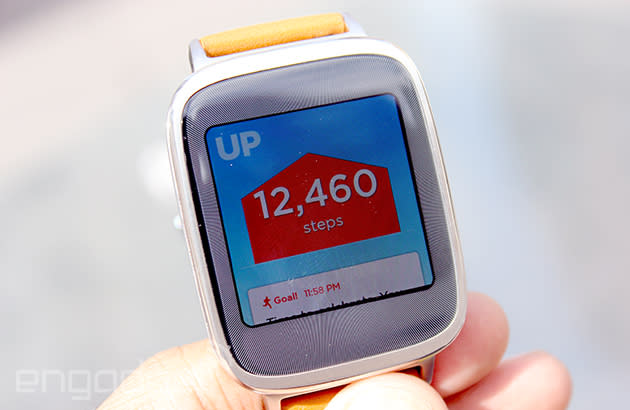
Let's just get this out of the way now: The ZenWatch's 1.63-inch AMOLED screen isn't eye-catchingly round like some others out there, but that's no reason to write it off. After all, didn't a wise bard note ages ago that it's hip to be square?
Painfully dated jokes aside, the screen's generally a pleasure to cast your eyes on, even if those peepers have been spoiled by the smartphone the watch is connected to. It runs at 320 x 320 (that's a pixel density of 278 ppi, if you're keeping count), making it marginally crisper than the G Watch R, though Sony's SmartWatch 3 still beats it by a hair. Your eyes almost certainly won't notice a few extra pixels per linear inch, though, so there's not much point in getting too worked up over pixel density -- the ZenWatch's display is more than crisp enough to please all but the most scrutinous screen snobs. Oh, and since you'll be glancing down at an AMOLED screen, the bold colors Google likes are lively and vibrant with deep, sumptuous blacks to match. We're still a ways off from the holy grail -- a digital watch face that's as crisp and substantial as a physical one -- but this generation of wearables hasn't exactly left us wanting either.
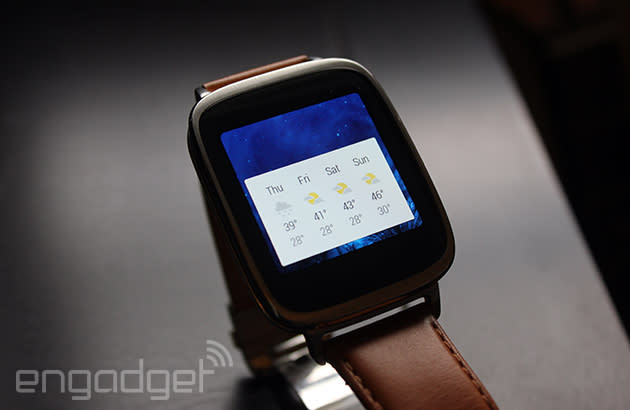
Then again, there's the matter of all that stuff around the screen. I've already mentioned the expanses of bezel surrounding the screen, and man -- I can't ever not notice it. Maybe it's because the rest of the watch is so clean, so elegant that the bezel just seems like filler. At the very least, it would've been nice if ASUS fitted an ambient light sensor tucked away in there, but no dice. You'll have to choose from one of five brightness levels manually, a process that takes a total of four to five swipes and taps to get where you'd need to go. My time with the ZenWatch has mostly been spent with screen brightness dialed up halfway and I never had trouble seeing who was furiously texting me, even under the light of the harsh winter sun. By default, you can smack your palm down on the screen to shut it off, though 99 percent of the time I just waited the few seconds for the screen to do it on its own.
In use
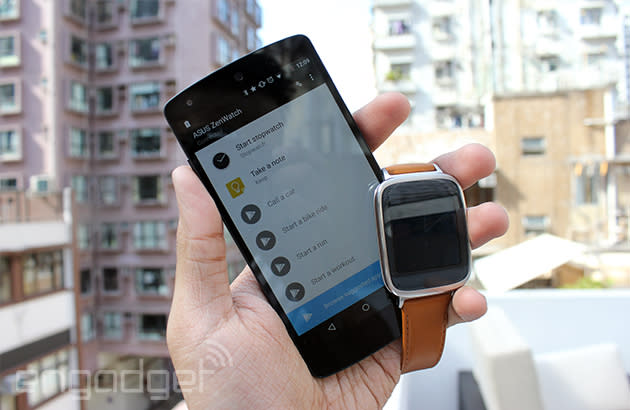
Go ahead, pick up any Android Wear watch and start poking around. I'll wait. It won't take you long to realize that beyond all the cosmetic niceties -- the chassis, the bands, the different watch faces -- they're all basically the same. The incessant flow of information in the form of Google Now cards and notifications? Mostly impeccable voice recognition for taking notes, issuing responses and launching apps? Tap-and-swipe-friendly navigation? All of the core bits are here on the ZenWatch and work just the way they always have, so forgive me for not dwelling on them much. It's a testament to Google's grip on the platform, but it puts the onus on smartwatch makers to turn something so uniform and consistent into something special.
In the case of the ZenWatch, most of those special bits lean on a separate Android app called ZenWatch Manager. From there, you can customize the colors of the seven included non-Googly watch faces, and fire up extra features like a proximity warning to alert you when you've wandered away from your phone and the option to mute your phone's ringer by clamping your hand over your watch. Useful, though not exactly thrilling. Just beware the occasionally spotty English that pops up now and again -- whenever I modify a watch face, a dialog box cheerfully confirms that my changes have been saved and says, "You could select the watch face on your watch to use it." I could, but should I?
ASUS also crafted a handful of apps for your phone that hook into the ZenWatch hardware, though you'll probably wonder why anyone thought they needed to exist. Consider Remote Camera for instance, an app that turns your watch into a combination viewfinder/remote shutter. It sounds nifty, but it's mostly silly in practice since you'll rarely find yourself in a situation when it isn't easier to just tap your phone's shutter button instead. Group selfies, maybe? You could feasibly use your phone as some sort of GoPro-esque action camera with the ZenWatch as a second screen, but you'd have to remain within Bluetooth range of the phone the entire time.
Since every wearable is concerned with your state of being, there's a heart rate monitor baked into the metal frame to help you keep tabs on your ticker. Unlike the heart sensors built into watches like the Moto 360, though, you'll have to place two fingers on that stretch of metal to get your reading. Problem is, the results are wildly inconsistent. While lounging in an uncomfortable airplane seat, the ZenWatch thought resting my heart rate leapt from 49 beats per minute to 65 to a whopping 172 within the span of about three minutes. If that was at all accurate, I should've asked a flight attendant to find a doctor on board stat, but I survived that flight just fine, thanks very much. An additional Wellness app for your connected phone keeps tabs on your movement and heart rate data (sketchy though the latter may be) and plots it all on a daily timeline for you to skim.
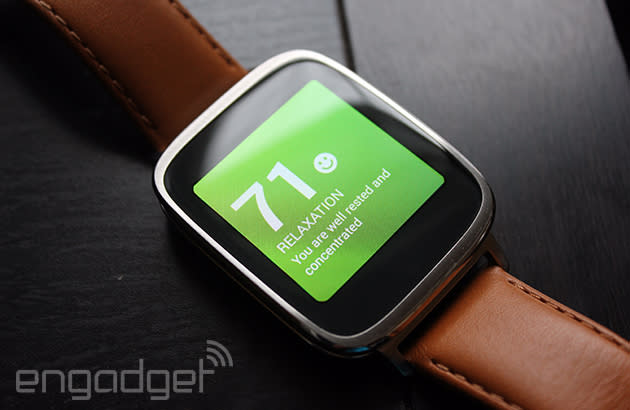
Curiously, the app also lets you view your heart rate in terms of relaxation in case you didn't know how stressed you were at any given moment. Yeah, really. I'd just as soon stick to the Jawbone Up app that comes preloaded on the watch. It's a worthy supplement to Google's own Fit heath-tracking platform. Over the years, I've burned through no less than three Jawbone Ups/Up24s thanks to seemingly shoddy quality control, a bummer considering Jawbone's mobile app is one of the more pleasant on-the-go fitness apps you'll find; it's heartening to be able to use it again with hardware that I'm not constantly fretting over.
If anything, it's the little disappointments that seem to sting the most. I'd occasionally miss a notification (or even worse, an alarm early in the morning) just because the vibration motor thrumming on my wrist was too weak to catch my attention. Oh, and the accelerometer very rarely had trouble keeping up when I brought the watch up to my face, so I occasionally had to crank my wrist like I was revving a motorcycle to bring up the full display.
Performance and battery life
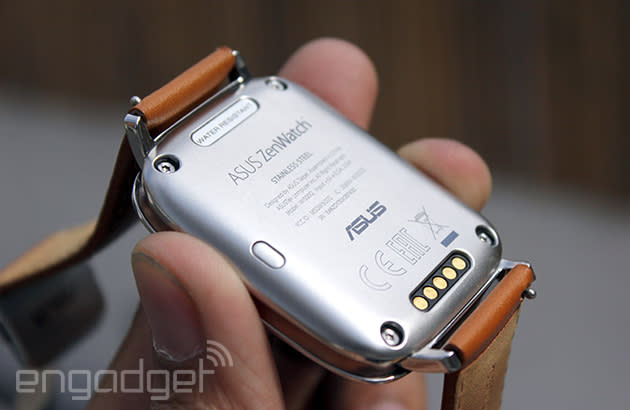
The ZenWatch has the same innards as several other Android Wear devices, like the G Watch R, right down to the 4GB of internal storage for your tunes. Naturally, that means the ZenWatch performs just as well as the rest of its rivals: Swiping through app and notification cards is usually pretty snappy, though you might spot some slowdown when you're trying to dismiss loads of them one after the other. It's still a little tricky to quantify how well these things perform in the real world, but hey -- even at its slowest, the ZenWatch managed never to be outright irritating. Considering all the bits of code and silicon needed to keep a smartwatch running smoothly, that's still a notable feat.
Now we're getting to the part you're probably most interested in: battery life. I used the ZenWatch every day over the course of two weeks, and those days were spent triaging a pretty steady stream of Hangouts messages, emails and Google Now info blasts. Throw in plenty of wrist-talking and you've got a situation that skews more toward the power-user end of the spectrum. On those heavier days, the watch's 369mAh battery would keep ticking for about 13 or 14 straight hours before giving up the ghost. That's about on par with what people are getting out of a post-update Moto 360, and just a hair better than what we saw with Samsung's Gear Live. Here's the thing, though: Your mileage is almost definitely going to vary from mine, depending on how frenzied your average day is. With any luck, your wrist won't be blowing up constantly, so you can enjoy the simple pleasure of looking at the time for longer.
Speaking of, what happens when you just want to use it as a watch, no smarts involved? Well, with Airplane Mode and the always-on display enabled, the ZenWatch generally stuck around for closer to 20 hours or so before it needed a spin in the awkward, little charging dock that comes with it. Naturally, once you shut off the always-on feature, the watch lasts quite a bit longer; I could usually use the thing for nearly two whole working days.
The competition
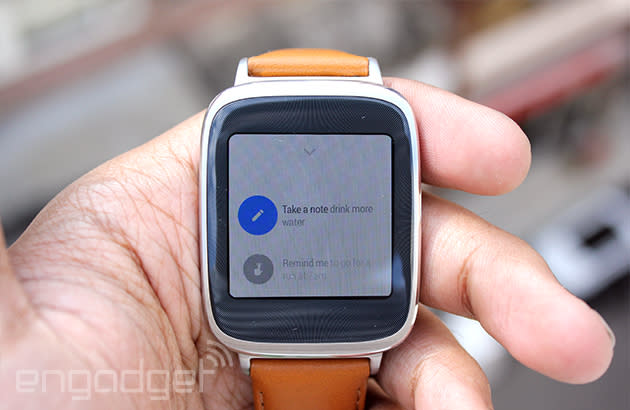
The number of Android Wear watches out there is starting to swell, and that leaves us with one weighty question to ponder: How does the $200 ZenWatch compare to everything else on the market? Well, its looks and build quality alone are enough to warrant a purchase over the first-gen Samsung Gear Live and LG G Watch, especially considering the latter still somehow costs an extra $30 over the others. The remainder of the ZenWatch's rivals are a bit more style-conscious, and at that point it all comes down to which approach you prefer.
Both LG's G Watch R and the Moto 360 come with those handsome round displays, and they score points for having heart rate monitors that you don't need to mash your fingers onto. Those little advancements are going to cost you though: The new G Watch R will set you back a cool $299 (honestly a little ludicrous for an Android Wear device), while the Moto 360 is a bit easier on your wallet, at $250. To be honest, I swooned hard when the 360 was first unveiled -- and so did many of our readers -- so it just might be worth the $50 premium. Oh, and if you don't mind its purely utilitarian looks and need something that doubles as a workout partner, Sony's $250 SmartWatch 3 might also be a good fit. We're still waiting to officially put that guy through its paces, though early reviews seem plenty promising.
Wrap-up
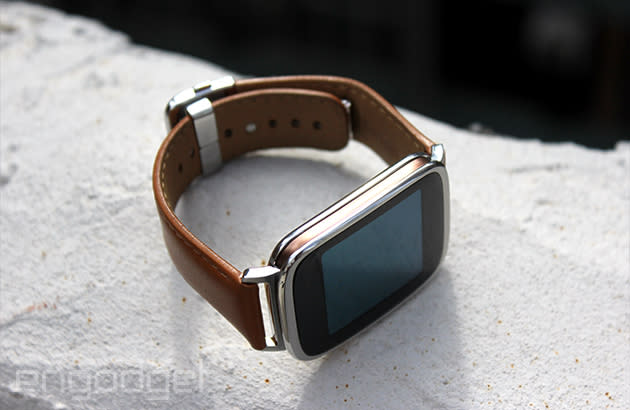
There's still no such thing as a perfect Android Wear watch, but ASUS' first offering sadly doesn't do much to stand above the crowd. The ZenWatch's design is the biggest reason to own one -- it's subtly stylish and comfortable in a way that other players' efforts just aren't. All things considered, ASUS has a solid grasp on the smartwatch basics, but I spent my weeks with the thing hoping to be pleasantly surprised by more than how good it looks. Performance is on par with the rest of the pack. Battery life is better than middle of the road, but only just. Needless to say, that pleasant surprise never came.
Thing is, it's not entirely the company's fault: We're still watching Android Wear take its baby steps, and not a single company totally understands what features need to be added to the mix. On the flip side, the ZenWatch will only set you back $200 -- a fair bit less than what you'd pay for the Moto 360 or G Watch R. If you absolutely have to own an Android Wear device, then, you could do a lot worse than this, especially if you're tired of smartwatches that look super-masculine or like sports accoutrements. Sadly, months after Android Wear's launch, that'll still be a big "if" for most of you.


































